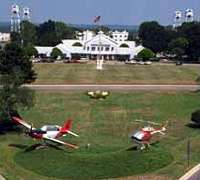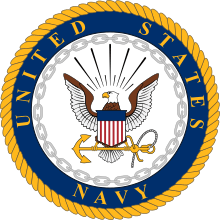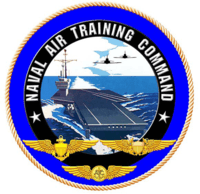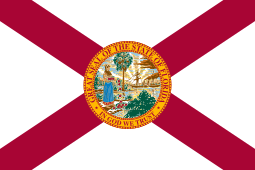Naval Air Station Whiting Field
Naval Air Station Whiting Field is a United States Navy base located near Milton, Florida, with some outlying fields near Navarre, Florida, in south and central Santa Rosa County, and is one of the Navy's two primary pilot training bases (the other being NAS Corpus Christi, Texas). NAS Whiting Field provides training for U.S. Navy, U.S. Marine Corps, Coast Guard, and Air Force student pilots, as well as those of several allied nations. NAS Whiting Field is home to Training Air Wing Five (TRAWING 5).
| Naval Air Station Whiting Field | |
|---|---|
| Santa Rosa County near Milton, Florida | |
 Base Headquarters aboard NAS Whiting Field | |
 Logo of NAS Whiting Field | |
| Coordinates | 30°42′45″N 87°01′06″W |
| Type | Naval Air Station |
| Site information | |
| Owner | |
| Controlled by | |
| Condition | Active |
| Site history | |
| Built | 1943 |
| In use | 1943–present |
| Garrison information | |
| Current commander | CAPT Paul Bowdich, USN |
| Garrison | |
| Occupants |
|
NAS Whiting Field is actually two airfields sharing a common support base. Primary Flight Training student aviators fly the Beechcraft T-6 Texan II from North Whiting Field (KNSE) while Advanced Helicopter Training takes place utilizing the TH-57 Sea Ranger at South Whiting Field (KNDZ).
Namesake
Whiting Field is named for Kenneth Whiting, who was commissioned from the United States Naval Academy on 25 February 1908. Whiting qualified in submarines, commanding USS Porpoise (SS-7), USS Shark (SS-8), USS Tarpon (SS-175), and USS Seal (SS-183). In 1914 he learned to fly under Orville Wright and was designated Naval Aviator number 16. He assumed command of the 1st Naval Air Unit in France following America's entry into World War I and was subsequently assigned to command Naval Air Stations 14 and 15 at RNAS Killingholme, England. He was awarded the Navy Cross "for exceptionally meritorious service in a duty of great responsibility." After the war he was partially responsible for the conversion of collier Jupiter into the Navy's first aircraft carrier USS Langley (CV-1). He subsequently commanded Langley and USS Saratoga (CV-3), and various air squadrons prior to his retirement as Captain in June 1940.
Operations
North Field is used solely for T-6 Texan II fixed-wing, primary flight training operations. Students from the United States Navy, Marine Corps, Coast Guard, and Air Force (as well as exchange students from various allied nations) go through the T-6B Joint Primary Aircraft Training System syllabus.
South Field is utilized for United States Navy, Marine Corps, and Coast Guard students in the Advanced Helicopter pipeline, flying the TH-57 Sea Ranger. Upon completion of this syllabus students will become designated Naval Aviators and assigned to their respective Fleet Replacement Squadron.
Squadrons


| T-6B Texan II | TH-57 Sea Ranger |
|---|---|
|
Outlying Fields
- OLF Barin (Primary Student Solo Field: Area 1)
- OLF Brewton (Secondary Student Solo Field: Area 2)
- OLF Choctaw
- OLF Evergreen (Primary Student Solo Field: Area 2)
- OLF Harold
- NOLF Holley
- OLF Pace (Helicopter Field)
- OLF Santa Rosa (Helicopter Field)
- OLF Saufley Field
- OLF Silverhill (Area 1)
- NOLF Spencer Field (Helicopter Field)
- OLF Summerdale (Area 1)
History
.jpg)
Naval Auxiliary Air Station (NAAS) Whiting Field was commissioned on July 16, 1943 by Rear Admiral George D. Murray, Commandant of the Naval Air Training Center, and the widow of Naval hero, Captain Kenneth Whiting, after whom the station was named. During construction, a prisoner of war camp was located at the station, providing additional labor.[1]
Jet trainers first arrived at Whiting Field in early August 1949 when eight TO-1 Shooting Stars transferred from NAS Corpus Christi, Texas as part of a new transitional jet training squadron to commence operations in September 1949, commanded by Lt. Cmdr. V. P. O'Neil, USN.[2] The Blue Angels demonstration team moved its headquarters to Whiting Field from NAS Corpus Christi, Texas, in 1955.[3]
See also
- NAS Whiting Field – North (T-6B fixed wing training only)
- NAS Whiting Field – South (TH-57 helicopter training only)
References
- "NAS Whiting Field". www.militarybases.us. Retrieved February 23, 2015.
- Fort Walton, Florida, "Jets Arrive At Whiting", Playground News, Thursday 4 August 1949, Volume 4, Number 27, page 7.
- Murphy, Leo, Commander, USN, Retired, "History of Naval Aviation in Pensacola", Part 9, Meyers, Paul, producer, Cox Communications, Florida/Georgia.
External links
- NAS Whiting Field (official site)
- Training Air Wing FIVE (official site)
- NAS Whiting Field page at Pensacola Chamber of Commerce
- NAS Whiting Field page at GlobalSecurity.org


